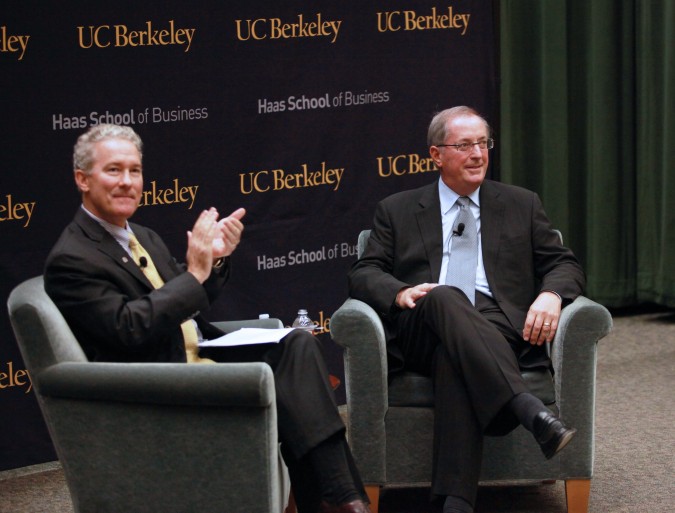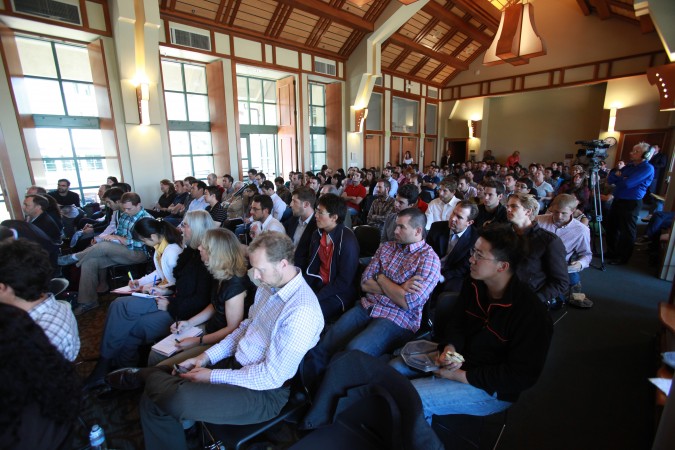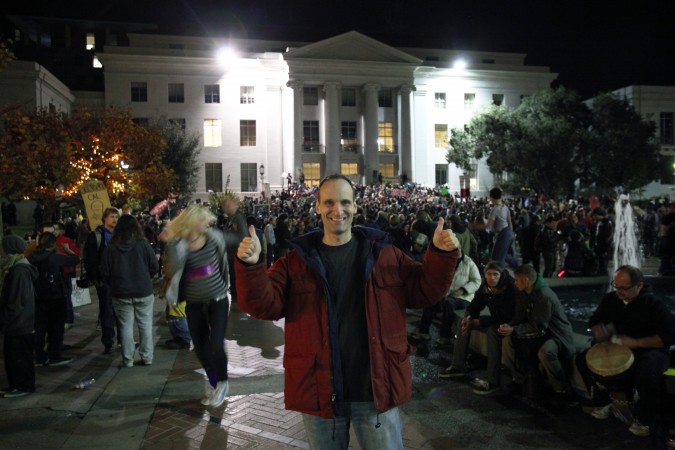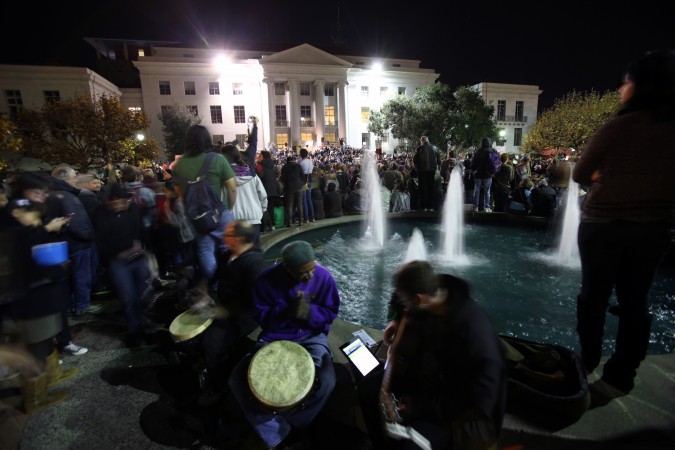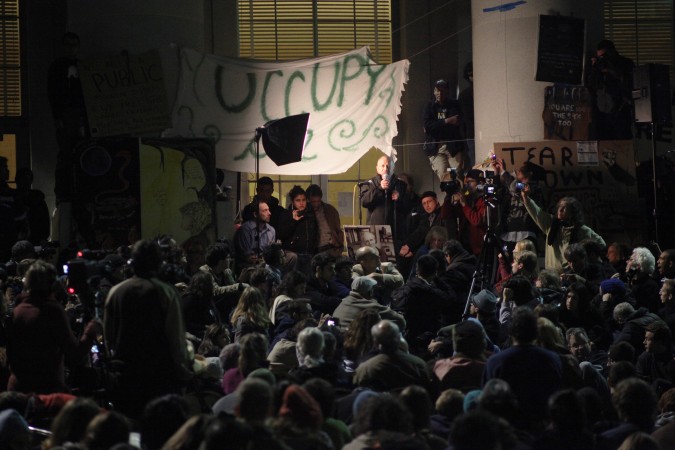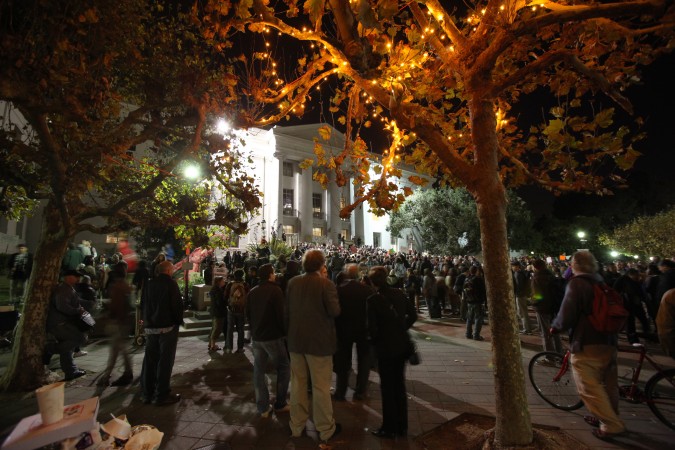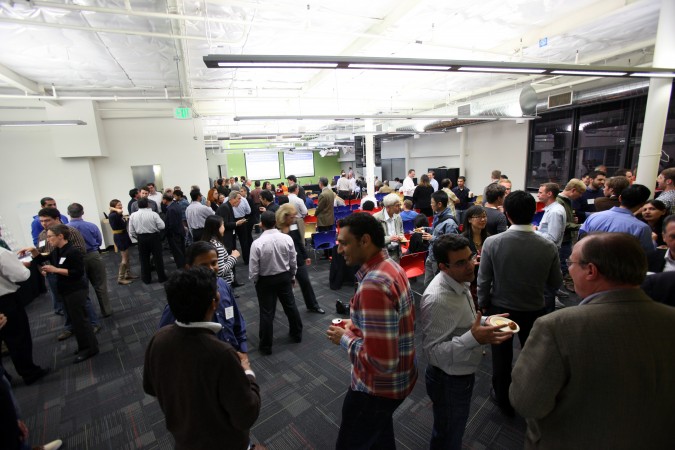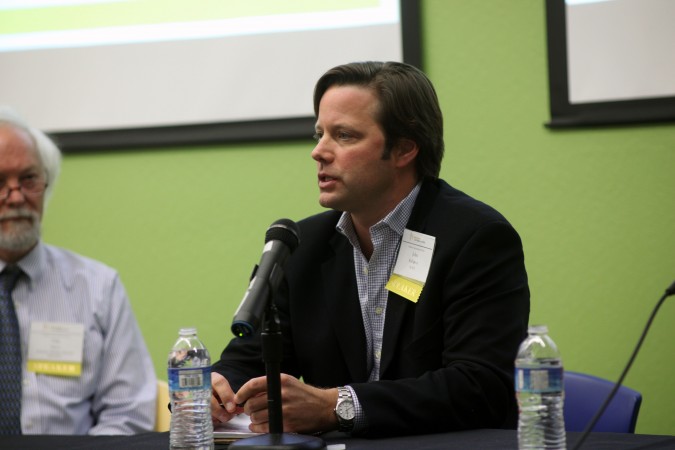Archive for the ‘Rich Lyons’ tag
Intel CEO Paul Otellini is interviewed by Haas School of Business Dean Rich Lyons, October 3, 2012 at University of California Berkeley

Intel CEO Paul Otellini at University of California Berkeley, October 3, 2012. Photograph by Kevin Warnock.
Yesterday afternoon, Wednesday, October 3, 2012, I attended the Dean’s Speaker Series at the Haas School of Business at the University of California Berkeley, in Berkeley, California USA.
Dean Richard Lyons interviewed Paul Otellini, the Chief Executive Officer of Intel Corporation. The question and answer session was held in the Anderson Auditorium, a venue I am very familiar with because it’s the same hall where the Berkeley Entrepreneurs Forum is usually held. I have attended the Forums for 20 years.
The interview was captured by a professional videographer, and the video will be soon made public on the Haas website page for the Speaker Series.
I have highlighted my favorite parts of Otellini’s remarks in my comments that follow.

Haas School of Business student asks Intel CEO Paul Otellini a question October 3, 2012 at University of California Berkeley
Otellini completed his undergraduate studies at University of San Francisco, and received his Master of Business Administration from the Haas School of Business, though at the time it was named the Berkeley Business School. Otellini got a job at Intel in 1974 with his freshly minted MBA degree. Even though Otellini was a finance specialist, his first job at Intel was to program a Digital Equipment Corporation PDP-10 minicomputer to perform cost analysis. This must have been an intense introduction to Intel for an MBA because mini-computers were not easy to program. I programmed a Digital Equipment Corporation VAX minicomputer in 1990, and it was difficult then, so I can only imagine how much more pesky and complicated it was to work 16 years earlier on the ancestor to the VAX.
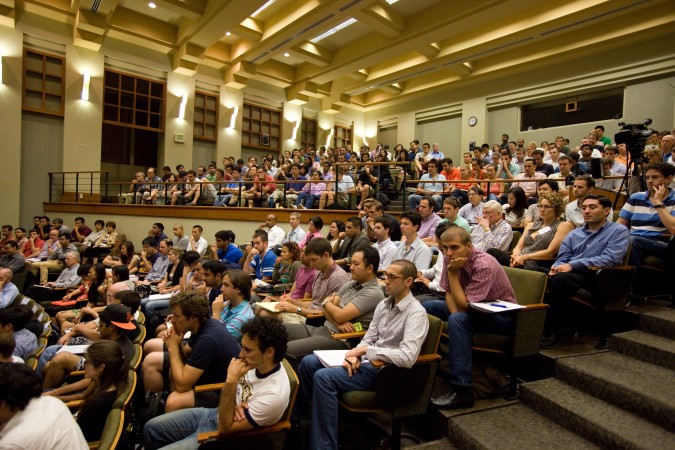
Audience watches Rich Lyons interview Intel CEO Paul Otellini, October 3, 2012 at University of California Berkeley, in Berkeley, California USA
When Otellini became CEO in 2005 he assessed that Intel was not organized correctly for where he saw the market heading. At the time, Intel had 105,000 employees. Otellini eliminated 25,000 jobs. The company is today back up to 103,000 employees. His advisers in 2005 were asking why he wanted to go into ‘the phone business’ when Intel was making money hand over fist at the time. Otelllini said he had many sleepless nights when he was contemplating letting 25,000 people go. He said he will never feel good about that, but he is grateful that he made the change well before the world financial collapse of 2008, so all the people let go were able to find jobs quickly.
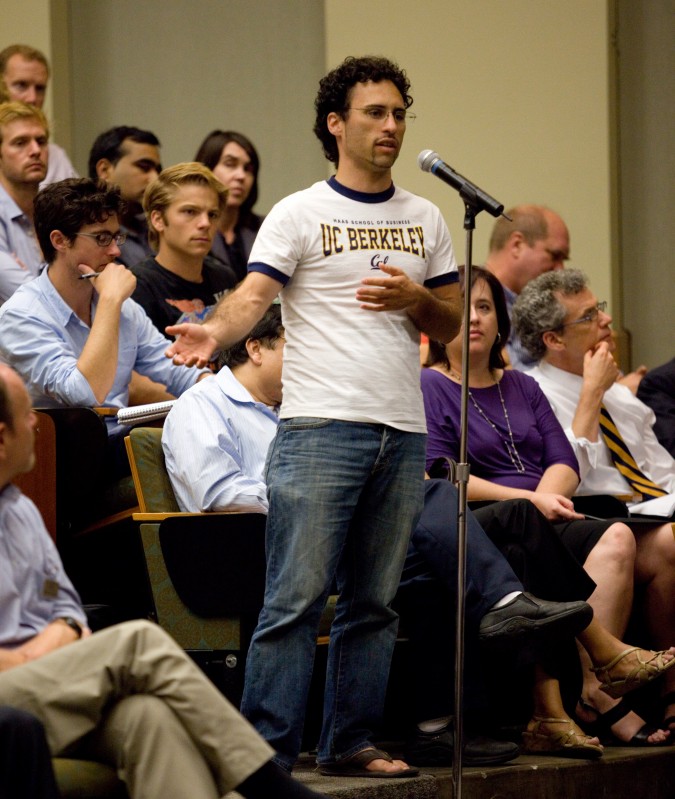
Second year Haas student Michael Vladimer asks Intel CEO Paul Otellini a question, October 3, 2012 at University of California Berkeley. To the right of the student, seated: Jill Erbland and Andre Marquis.
I was surprised to learn that Intel is the world’s 4th largest software company in the world based on the number of computer programmers that it employs.
Otellini advised to get work experience in different geographic locations prior to starting a family.
Otellini said its chips are manufactured in three dimensions, which was forced upon it by the laws of physics, which prevented circuits from being made much smaller. To keep making more capable chips, transistors had to be stacked as well as placed side by side. This technology took Intel 10 years to perfect, with thousands of PhD holders working on the effort.
I wonder if they considered adding a ‘Now in 3D!’ tagline to their famous ‘Intel Inside’ stickers.
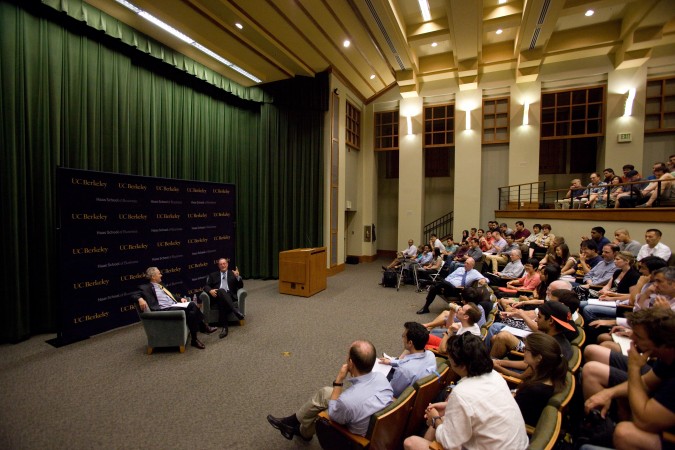
Audience watches Rich Lyons interview Intel CEO Paul Otellini, October 3, 2012 at University of California Berkeley
Otellini emphasized the high risks inherent in running Intel.
To illustrate, when Intel breaks ground on a new chip fabricating factory:
- the technology hasn’t been developed yet
- the products haven’t been designed yet
- the markets for the products don’t exist yet
These factories take 3 1/2 years to build and cost USD $5,500,000,000 each, and Intel starts construction on two or three of these per year.
That sounds like a great definition of high risk to me.
Intel makes hardware reference designs that it provides to its customers so that they can get products to market more rapidly. Otellini said personal computer makers don’t spend that much on industrial design, so they like and need Intel to provide these turn key designs they can modify to make them unique.
Otellini had a mentor at Berkeley while he was a student in the early 1970s. That mentor worked at Bank of America, and tried to get Otellini to join that bank. Several years after Otellini had joined Intel, his mentor confided that Otellini had chosen the right company.
Intel has put in place a system where they can identify the source of so-called conflict minerals. They can also track them, and Otellini said that Intel is likely to be able to say by January 2013 that Intel has built the world’s first ‘conflict mineral free microprocessor’.
Otellini said he had spoken in the morning with Robert Hormats, Under Secretary for Economic, Energy and Agricultural Affairs at the Department of State, who he said is very interested in [removing] conflict minerals from products. The Department of State, according to Otellini, wants to make Intel’s conflict mineral tracking system a so-called ‘best known method’ for the [semiconductor] industry.
Otellini said it recycles the chemicals used in its plants, and plans to recycle the water it uses to such a complete degree that its factories will be able to reuse the water they consume over and over, without needing to return it to the underground aquifers, like they do today.
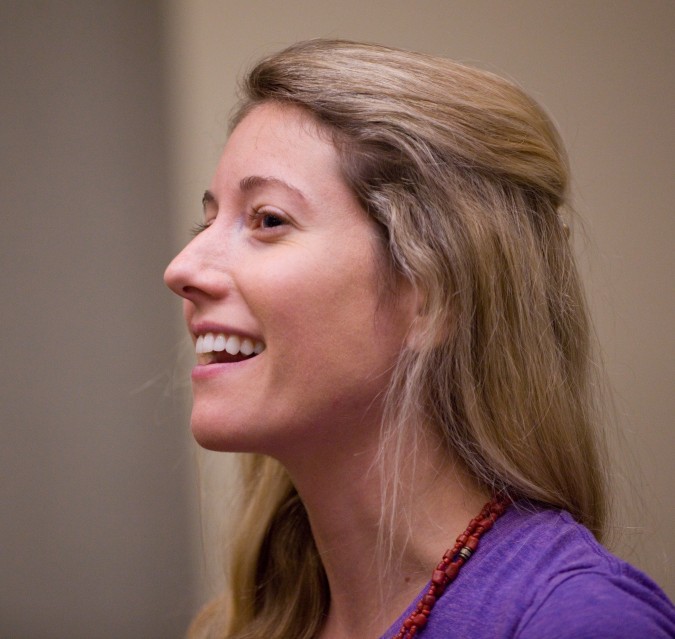
Audience member at Dean's Speaker Series with Paul Otellini at Haas School of Business, October 3, 2012.
Otellini spoke about manufacturing competitiveness generally in the United States, something he is qualified to speak about because he advises United States President Barack Obama about competitiveness.
He said many of the motivating factors that have led to outsourcing are disappearing. He said that it costs more for Intel to hire 1st and 2nd level technical managers in China now than it does in Santa Clara, California USA. For engineers with 3 or 4 years of experience, the costs to hire them are now the same in the US as they are in China and India.
Otellini said that the United States could improve its position by lowering its corporate tax rate [to a level consistent with the rate in competitive economies]. He suggested the US streamline its permitting procedures for building new factories. He suggested that job training be improved to provide a skilled workforce to work in the new factories. He pointed out that currency and political risks are low in the US, and stated there is no risk of a company’s factory being expropriated by the US government. In other countries, governments sometimes do take over privately owned factories.

Paul Otellini speaks with Arthur Gensler at University of California Berkeley, October 3, 2012. Photograph by Kevin Warnock.
There were some famous guests in the audience.
Perhaps the most famous attendee was Arthur Gensler, the founder of M. Arthur Gensler Jr. & Associates, Inc. but commonly referred to as simply Gensler. I have been aware of this global architecture, planning, design and consulting firm since I was 23 years old at my first job out of college, at Newell Color Laboratory at 630 Third Street in San Francisco, California USA, since closed. Gensler was an important client. I suspect Gensler may be helping to design the new building Dean Lyons is being planned for the Haas School of Business campus.

Arthur Gensler speaking with Paul Otellini, October 3, 2012 at Haas School of Business at University of California Berkeley
After the interview, Lyons pointed out Mr. Gensler to me — without his helpful comment, I would not have been able to write this acknowledgment of his visit. Gensler is a big deal — they employ 3,500 people in 42 locations. They count all 10 of the Fortune 500 top 10 companies as clients.
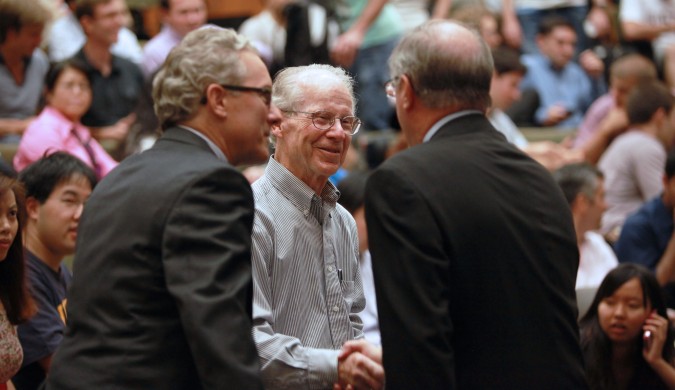
Haas School of Business Dean Rich Lyons, left, watches Haas Professor Emeritus and Nobel Prize winner Oliver Williamson shake hands with Intel CEO Paul Otellini at Haas School of Business at University of California Berkeley, October 3, 2012. Photograph by Kevin Warnock.
Perhaps the second most famous attendee was Oliver Williamson. Williamson is Professor Emeritus at the Haas School of Business. In 2009 Williamson won the Nobel Prize for Economics. I saw Williamson speak in 2009 at the Haas Gala, the annual party the school throws each November. I blogged about that gala and wrote about Williamson, who spoke at the event. I took a picture of Williamson shaking hands with Otellini, shown here.
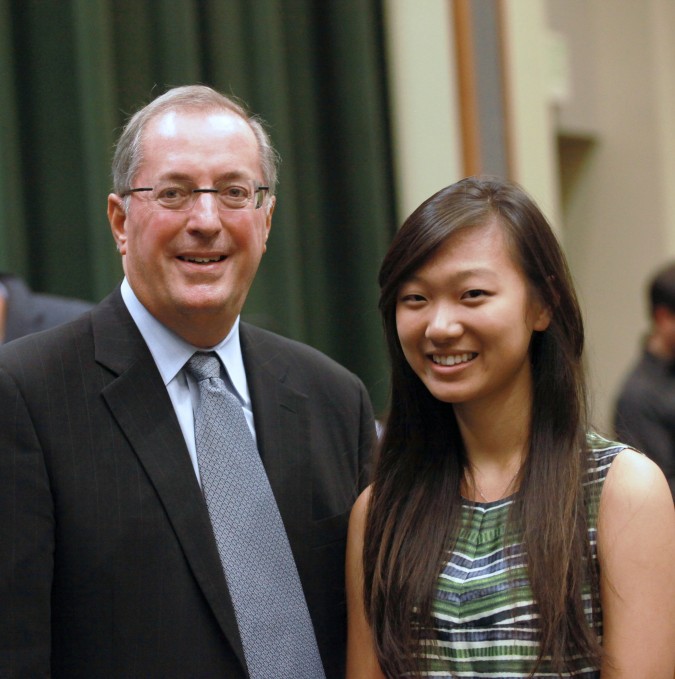
Intel CEO Paul Otellini with University of California Berkeley student Tammie Chen. Photograph by Kevin Warnock, October 3, 2012.
This last photograph of Mr. Otellini with Berkeley undergrad student Tammie Chen has an interesting story behind it.
I met Chen when she was an organizer for the 2011 Made for China Startup Pitch Competition. I was a judge for that competition. After that event, we became friends on Facebook, and she posted that she was going to be attending the Dean’s Speaker Series that is the subject of this blog post. I commented that I would be there as well, blogging. She asked me if I could take a picture of her with Otellini. I said I would. I walked up to him and asked him if I could introduce Chen to him and take a picture of him with her, and he readily agreed. They had a nice chat for a minute, and then they posed for this picture. Chen is a huge fan of Intel, and has visited their headquarters. She has a lot of friends that work at Intel.
I was surprised that no students approached Otellini to introduce themselves. This is the same behavior I saw at my first Dean’s Speaker Series event, in September 2012, when Lyons interviewed Randall Stephenson, the CEO of AT&T. There were students standing about 10 feet away from Otellini, in a large circle, but not a single student walked into the empty space to say hello. That made it easy for me to say hello to Mr. Otellini, who I have met and spoken with before, in 2008, at the Intel Capital CEO Summit [renamed the Intel Capital Global Summit] in San Francisco.
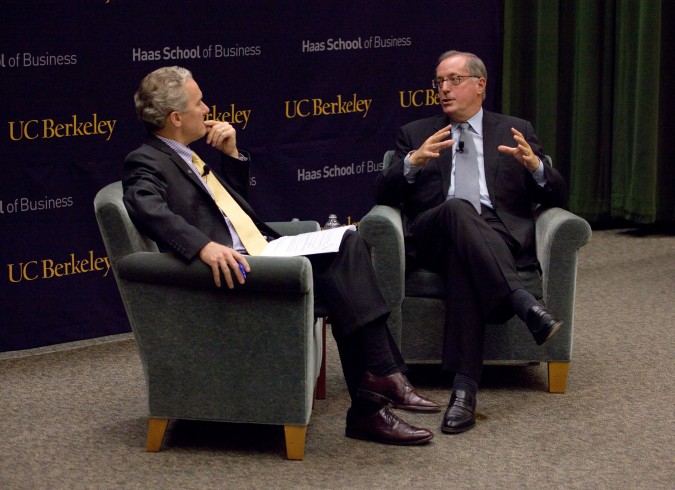
Haas School of Business Dean Rich Lyons and Intel CEO Paul Otellini, October 3, 2012 at University of California Berkeley. Photo by Kevin Warnock.
I like Intel. Their venture capital division Intel Capital was very nice to my company Silveroffice, Inc. by making it an Intel Capital Portfolio Company. Intel Capital invites me as their guest to Intel’s annual Intel Developer Forum, at which I get a new Intel Developer Forum branded laptop bag or backpack, which I use every time I leave my home with my Intel powered laptop. I hope to be appointed a judge for the Intel Global Challenge, a role I would be great at since I was a judge for the Berkeley Startup Competition for eight years through 2011. My application is pending, so please wish me luck! I love judging startup competitions, and so far I have judged four different competitions at University of California Berkeley.
I took all the photographs in this post. I used a Canon 5D Mark II camera with a Canon 80-200mm f:2.8 L zoom lens. Click on the images twice in delayed succession to see the images at full size. I uploaded the images at their full 21 megapixel resolution, at a JPG quality of 12. The light level was comparatively low, so I shot at ISO 2,500, without flash.
Thank you to Meg Fellner of the Dean’s Office for getting me a ticket to this sold out event.
AT&T CEO Randall Stephenson is interviewed September 6, 2012 by Rich Lyons, the Dean of the Haas School of Business at University of California Berkeley

Rich Lyons, Dean of the Haas School of Business at UC Berkeley interviews Randall Stephenson, the CEO and Chair off ATT, September 6, 2012. Photograph by Kevin Warnock.
On Thursday, September 6, 2012, I attended the Dean’s Speaker Series at the Haas School of Business at the University of California at Berkeley, in Berkeley, California USA.
This was the first Dean’s Speaker Series I have attended.
I have been aware of this series for years, but I assumed attendance was restricted to friends of the Dean, Rich Lyons, because of the name of the event.
I’ve met and spoken with the Dean about ten times over the years, I estimate, including when he was the Acting Dean when Dean Tom Campbell took a leave of absence to help then Governor Arnold Schwarzenegger manage the finances of the State of California.

Rich Lyons, Dean of the Haas School of Business at University of California Berkeley, asks Randall Stephenson a question, September 6, 2012. Photograph by Kevin Warnock.
A couple of weeks ago I was looking over the Haas website and marveled at the outstanding list of upcoming individuals the Dean will be interviewing on stage. There in front of me were the magic words — the events are open to members of the Haas ‘community.’ I was pretty sure I qualified, since I am a sponsor of one of the school’s premier events, the Berkeley Startup Competition, and have been every year since 2000. I inquired and I got a seat — I was and am thrilled.
The Dean’s guest for this event was Randall Stephenson, the Chief Executive Officer of AT&T, the largest telecommunications company in the United States.
I am an AT&T customer, both for my home’s broadband Internet connection and for my wireless Apple iPhone 3GS, which I bought soon after launch. I no longer have a wired phone. I like AT&T’s service — I get great reception and few dropped calls.
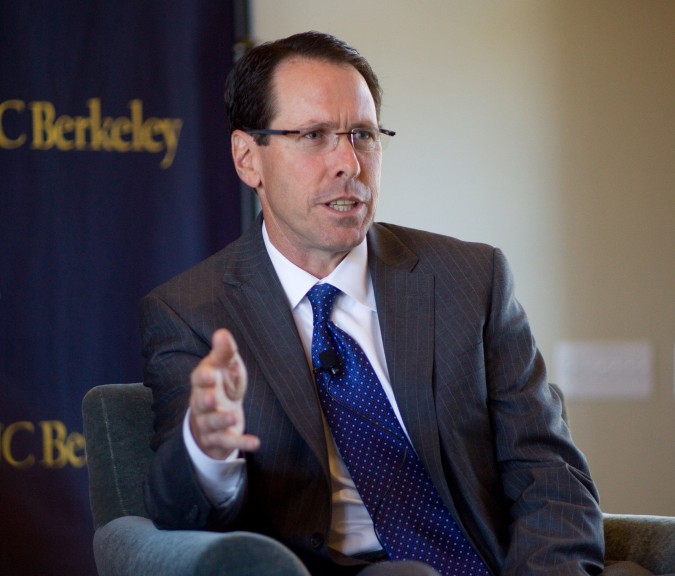
Randall Stephenson, Chair and CEO of AT&T, photographed by Kevin Warnock on September 6, 2012 at UC Berkeley
My regard for AT&T went up after listening to Stephenson speak for an hour. Stephenson was Chief Financial Officer and Chief Operating Officer prior to becoming Chair and CEO, among many roles.
He started at a job he called a ‘tape monkey’ at Southwest Bell Telephone in 1982 loading 19 inch diameter magnetic tapes of billing data onto tape drives. He did this work 12 hours a day — reading a video screen for instruction on which tape to load, finding the tape in storage, loading the tape and then pressing ‘Run.’
I did this same job, though not full time and not for 12 hours a day, when I worked at Cooley LLP. Thankfully I only had to do this role about two weeks a year, when the regular tape technician, Bill Calhoun, went on vacation.
Stephenson said he figured a way to rework his tape loading job to make it much more efficient and enjoyable, though he didn’t tell us the details of what he changed.

Rich Lyons, Dean of the Haas School of Business at University of California Berkeley, listens to Randall Stephenson answer a question, September 6, 2012. Photograph by Kevin Warnock.
During his introductory remarks, Rich Lyons said Stephenson worked in Mexico City as SBC’s Director of Finance.
At some point, Stephenson worked in Mexico for Carlos Slim, the iconic leader of Telmex. Stephenson did not explain how he came to work for Carlos Slim, who presumably was not an SBC employee at any point in his life.
Stephenson said Carlos Slim is ‘the most inherently brilliant individual that I’ve ever worked with.’
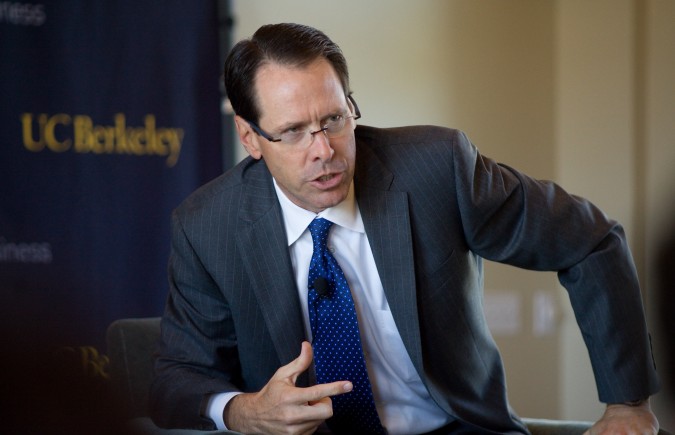
Randall Stephenson, CEO and Chair of AT&T, speaks at University of California at Berkeley, September 6, 2012. Photograph by Kevin Warnock.
Stephenson was in Mexico working for Slim in 1994 when there was an economic crisis that began December 19, 1994, when the Mexican government lifted all restraints on the Mexican Peso and let its value float. The Mexican currency lost 40% of its value in one day, Stephenson recalled.
Slim had 20,000 wireless subscribers in 1994, and thanks in part to the aggressive investments Slim made in the aftermath of the economic crisis of 1994, TelMex now has over 200 million wireless subscribers and Slim has made himself reportedly the wealthiest man in the world.
Stephenson took his job as CEO in June 2007 when ATT was a $100B annual revenue company with 300,000 employees, the same month that Apple launched its first iPhone. Stephenson invested heavily when the 2008 financial crisis came.
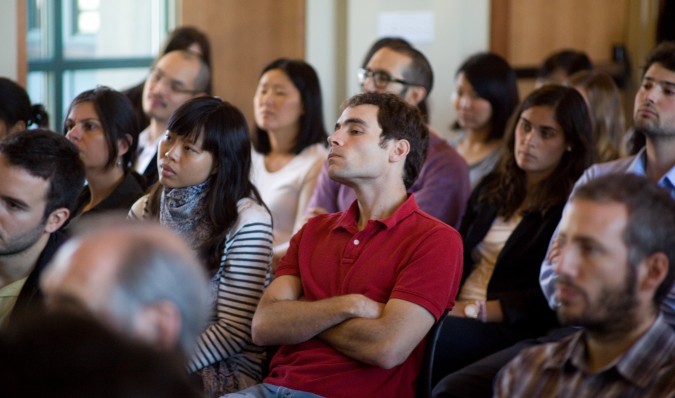
University of California Berkeley students listen to AT&T CEO and Chair Randall Stephenson speak, September 6, 2012
Stephenson said that 170,000 of AT&T’s employees actively participate in its TIP — The Innovation Pipeline — system conceived by the company’s CTO, a guy so tough to hire that it took ten years for Stephenson to do so. This system allows employees to propose ideas for the company to work on developing. People vote on the ideas and the best ones that float to the top are funded and pursued. In response to a question from a student in the audience, Stephenson said that apart from advertising the program to employees the company does little to promote participation. He said participation is quite good.
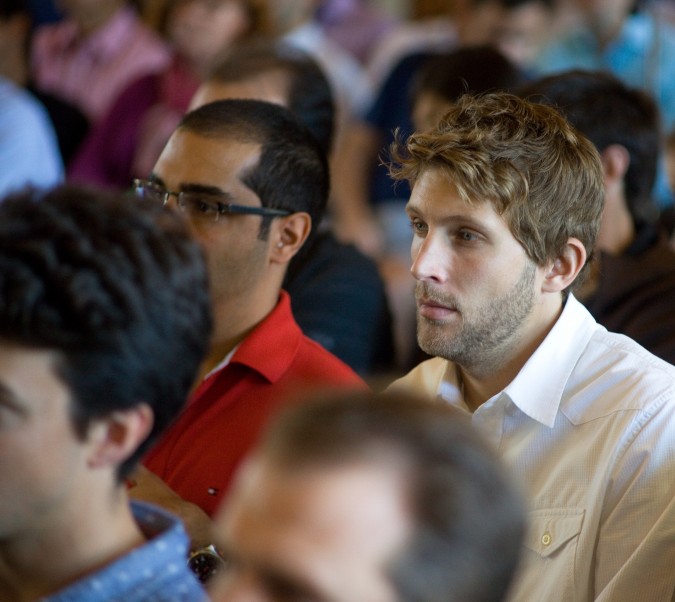
University of California Berkeley students listen to AT&T CEO and Chair Randall Stephenson speak, September 6, 2012
Stephenson and and his public relations person Larry (last name not mentioned) said they were so excited about a couple of their ‘tattooed up’ technologists in their Palo Alto, California research lab named the ‘Foundry’ that they put photographs of them in AT&T’s Annual Report. Stephenson divulged that competitors now are ‘coming after’ these programmers trying to hire them away from AT&T.

University of California Berkeley student asks AT&T CEO Randall Stephenson a question about AT&T's TIP suggestion system, September 6, 2012. Photograph by Kevin Warnock.
A student from the audience asked Stephenson to discuss wireless handset subsidies. Stephenson answered at length and concluded that the current system in the United States is overwhelmingly what customers want. He said AT&T performed studies where customers were asked if they would like to finance a phone via a separate finance contract, in exchange for markedly lower rates for service. Stephenson said customers did not like this proposal.
I think the survey respondents that answered this way are short sighted.
The way things operate in the United States, where one can buy a USD $700 iPhone for $200 because of the carrier subsidies, there is a perverse incentive to upgrade your phone exactly every two years. That is because contracts generally run for two years. If you keep a phone for three years, that final year you are paying much more than is warranted for service.
People should be encouraged to save money, not spend, so I admire the relatively new system reported by Stephenson to be the norm in Europe — phones are not subsidized and rates for service are [I hope] commensurately lower. Stephenson said phone sales dropped dramatically when this policy was implemented, but I say that is just what the world needs. People keep a home phone for decades. People keep televisions, stereos and other household appliances for years. Stephenson told me one-on-one after the event that fully 90% of his company’s customers upgrade their wireless phone every 14 months. Since contracts are two years long, 90% of its customers are paying early termination fees, which decline over time. That is a waste of the world’s resources, even in this day of a vibrant resale market for used mobile phones. I’m pretty sure a lot of people just throw their old mobile phones in a drawer, to benefit nobody. I understand mobile phones improve rapidly, and I do plan to get the latest iPhone when it’s available, having skipped the iPhone 4 and iPhone 4s. I just don’t approve of upgrading exceptionally frequently, which I consider 14 months to be.
I encourage AT&T and all carriers to offer unbundled rates for mobile service, as an option.
Rich Lyons is a good interviewer. The setting was photogenic — two handsome cushioned arm chairs on an elevated stage, with a small end table between the chairs. Lyons and Stephenson wore wireless lapel microphones. There was a backdrop behind the men that repeated the logos for UC Berkeley and the Haas School of Business, so the logos made it into every photograph of the people on stage. As a photographer, I applaud the Dean for creating such an inviting, warm and photogenic environment for his interviews. I look forward with enthusiasm to the next Dean’s Speaker Series interview, which I hope to be able to attend.
Former Haas Dean Dr. Laura D’Andrea Tyson is on the Board of Directors of AT&T, and presumably she helped Lyons recruit Stephenson to visit the Haas School. Tyson was Dean when I was a finalist in the Berkeley Business Plan Competition in 1999 with my company Hotpaper.
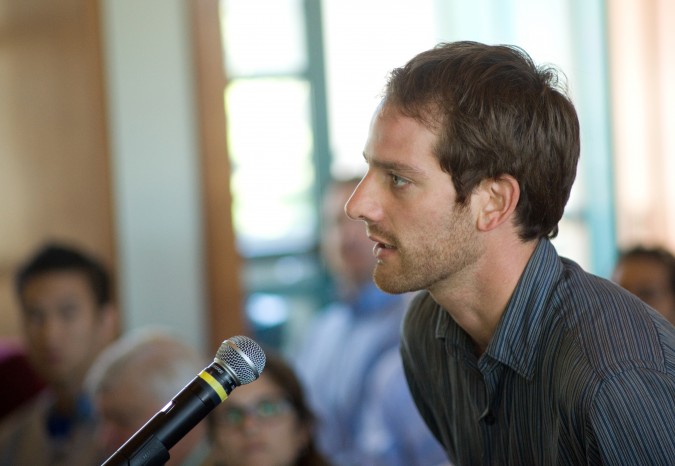
Student asks AT&T CEO and Chair Randall Stephenson a question about mobile handset subsidies, September 6, 2012, at University of California Berkeley
I took the photographs that accompany this blog post.
I used a Canon 5D Mark II camera with the following lenses: Canon 135mm soft-focus lens set to sharp, Canon 16-35mm L zoom lens. I upload pictures to this blog at maximum camera resolution at maximum image quality. Click on the photographs twice in delayed succession to see the full size images. If you would like to use these pictures, please send me a message. If the purpose is reasonable, I will allow usage. I enjoy having my pictures displayed elsewhere. I pursue photography only as a hobby, not as a profession.

At the end of his interview, Rich Lyons stands with ATT CEO and Chair Randall Stephenson at the Haas School of Business, September 6, 2012. Photograph by Kevin Warnock.
Finally, I have some advice for Berkeley students reading this post — introduce yourself to the speaker.
I don’t recall seeing any students introduce themselves to Stephenson. I did see a professor and a president of a good sized company say hello, but that’s it. Stephenson spent several minutes talking with me because there was nobody waiting after me to speak with him. The room had rapidly cleared out. The interview was during the lunch hour, so perhaps the students had to be in class immediately after. It’s rare for so prominent a CEO to speak to such a small group — there were about 140 students in the room by my quick count. I’m sure Stephenson won’t be back this academic year. Make a point of meeting all such prominent speakers. In my mind, Stephenson should have been surrounded by dozens of students trying to shake his hand. Stephenson didn’t appear to be in a rush to depart, and I left before he did.
Occupy Cal protest at University of California at Berkeley November 15, 2011
I was at the Occupy Cal protest at University of California at Berkeley last evening, November 15, 2011. There were over 1,000 protesters there. The energy in the air was positive and infectious.
As far as I could detect, the Occupy Cal event wasn’t marred by the shooting of a Berkeley student by campus police earlier in the afternoon. That student later died at the hospital. That student, Christopher Nathen Elliot Travis, age 32, was a transfer student from Ohlone College in Fremont, California.
Haas School of Business Dean Richard Lyons addressed the school’s students this morning. Later, Lyons posted this letter to the Haas Newsroom and publicized it via the micro-blogging website Twitter.
My friend Heather Sepulveda went to Ohlone College before she transferred to UC Berkeley years ago — a very strange coincidence to be sure.
There was a drum beat to the protest, thanks to the talented musicians that showed up. One of the musicians looked to be about 60, and he said he had participated in the anti war protests at UC Berkeley in the 1960s. I feature some of the music in the video I am editing from the event, which I hope to post tomorrow. I got some great video, including of the camping tents being carried into place.
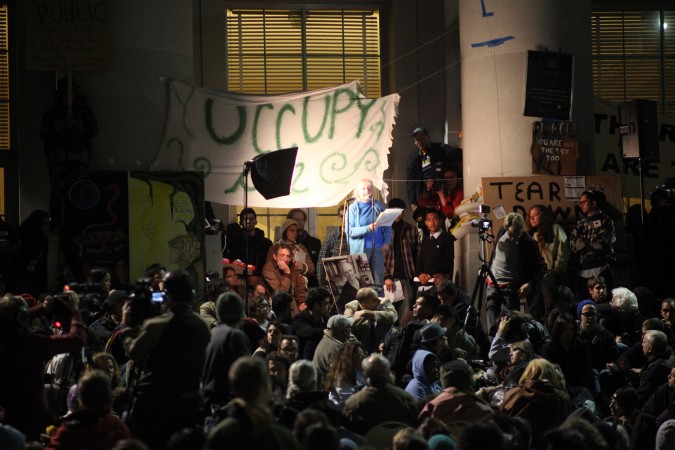
Board member of the Mario Savio Lecture Fund addressing Occupy Cal protesters November 15, 2011 at Sproul Plaza
The event incorporated a gathering of The Savio Lecture Fund, which originally was to take place indoors at the Pauley Ballroom in the Martin Luther King Jr. Student Center, also on the UC Berkeley campus. My guess is the change of venue was decided close to the last minute to benefit from the association with the Occupy Cal movement. I was not previously familiar with Mario Savio, I am embarrassed to admit. I concluded from the talks I heard last night that Savio would have embraced the Occupy Cal movement and message. Savio spoke on December 2, 1964 from the same steps of Sproul Hall where the speakers last night spoke from.
The Savio Lecture speaker last evening was former United States Secretary of Labor Robert Reich, who is a Professor of Public Policy at UC Berkeley. I captured his speech to high definition video and presented it on my blog earlier today.
In the photograph above you can see some of the camping tents already in place, along with another tent being carried into place already set up. Organizers were distributing hot food on the Sproul Hall steps. Even though there were a lot of people there, it was possible to easily move among the crowd, and I had no trouble taking pictures and video, even though I had brought a tripod with me, for many of the time exposures I took to capture the low light images you see here.

Soap bubbles by the hundreds liven up the view from the steps of Sproul Hall during Occupy Cal protest at UC Berkeley November 15, 2011
I took the above shot right before I departed, after 10pm. The group front and center appeared to be in their 50s and 60s. The age mix of the crowd was inspiring — it definitely wasn’t just current students in their teens and twenties. I felt that people were really passionate about the Occupy movement, and that this movement will be long lived and will accomplish real change in the world. I am glad I made the trip from San Francisco.
I uploaded these pictures at full 21 megapixel resolution. To see them at full size, click on them twice, with a pause in between the clicks to allow the photographs to load in a separate window. If you’d like to use these pictures for something, please give me a link back to my blog. If you like this blog, please subscribe, and please add this post to your status feed on Facebook. Thank you!
Berkeley Entrepreneurs Forum at Google, Inc. headquarters, October 27, 2011
Thursday October 27, 2011, I attended the first Berkeley Entrepreneurs Forum ever held away from the University of California at Berkeley campus.
The Forum was held in Building 40 at Google, Inc. headquarters in Mountain View, California USA. Getting to the event was a challenge because Google was throwing a huge celebration for the Indian national holiday Diwali. As a result, parking was tight and there were hundreds of people in the huge courtyard between the massive Google buildings. I’m not complaining for it was festive and an adventure. I photographed the 6,000 burning candles artfully arranged in the courtyard, as you can see at the bottom of this post. There was a live band. The Google cafeteria was packed. It was exciting.
The Entrepreneurs Forum was a small event compared to the outdoor Diwali celebration.
The title of the Forum was ‘Power Hungry: Developments in Energy-Efficiency Technologies for Data Centers.’ This was an appropriate event to have at Google, which I suspect runs the largest collection of computers in the world.
I learned a lot at this forum. For example, computer rooms that are chilly are computer rooms that are horribly inefficient. Modern servers can run fine at temperatures around 85F degrees, and sometimes even warmer. Here’s the official video, immediately above.
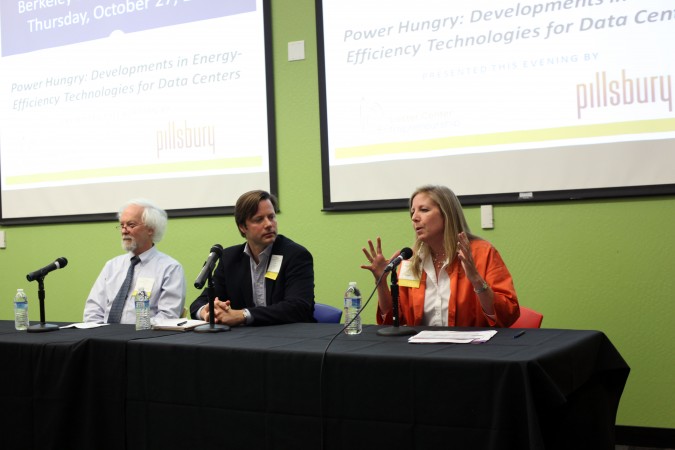
Dale Sartor, John Robison and Joyce Dickerson on panel at Berkeley Entrepreneurs Forum, October 27, 2011
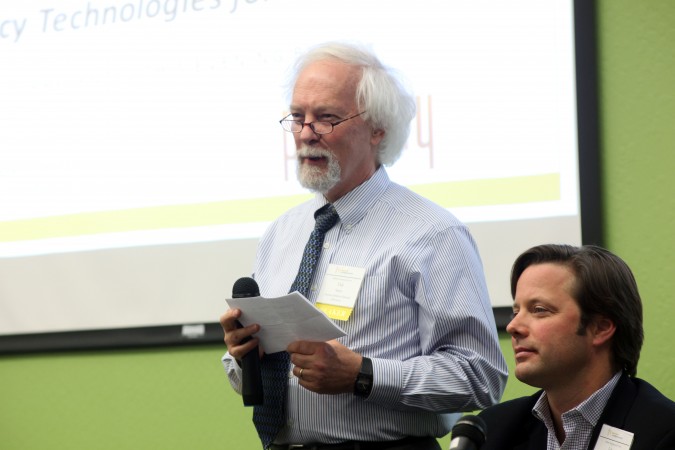
Dale Sartor, P.E., Applications Team - Environmental Energy Technologies Division, Lawrence Berkeley National Laboratory. Berkeley Entrepreneurs Forum, October 27, 2011

Joyce Dickerson, Sustainable IT at Stanford University, at Berkeley Entrepreneurs Forum, October 27, 2011

Sylvia Burks, Partner, Pillsbury Winthrop Shaw Pittman LLP, at Berkeley Entrepreneurs Forum, October 27, 2011
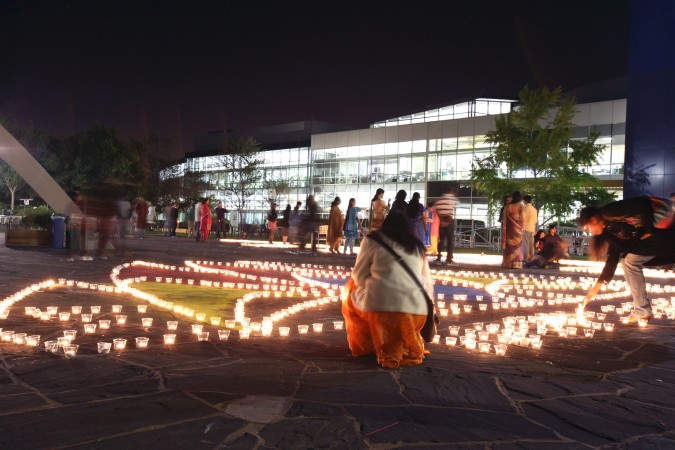
Diwali Festival of Lights with 6,000 candles at Google, Inc. headquarters in Mountain View, California, October 27, 2011. Photograph by Kevin Warnock.
[Note: I received a free pass to this event courtesy of my membership on the Advisory Council for the Berkeley Entrepreneurs Forum. I am writing here as a private citizen, not in any official capacity with UC Berkeley or the Berkeley Entrepreneurs Forum.]
